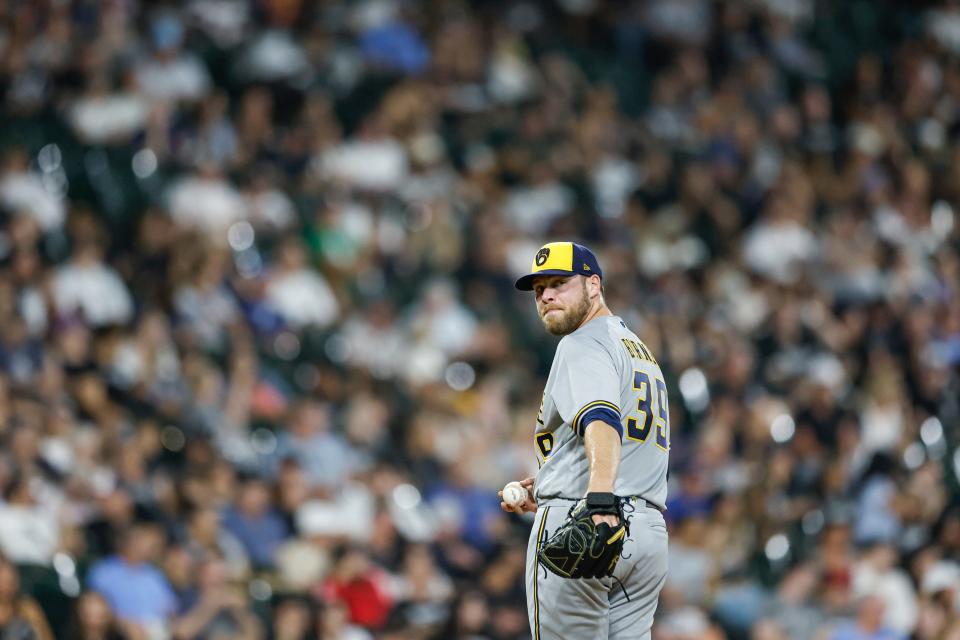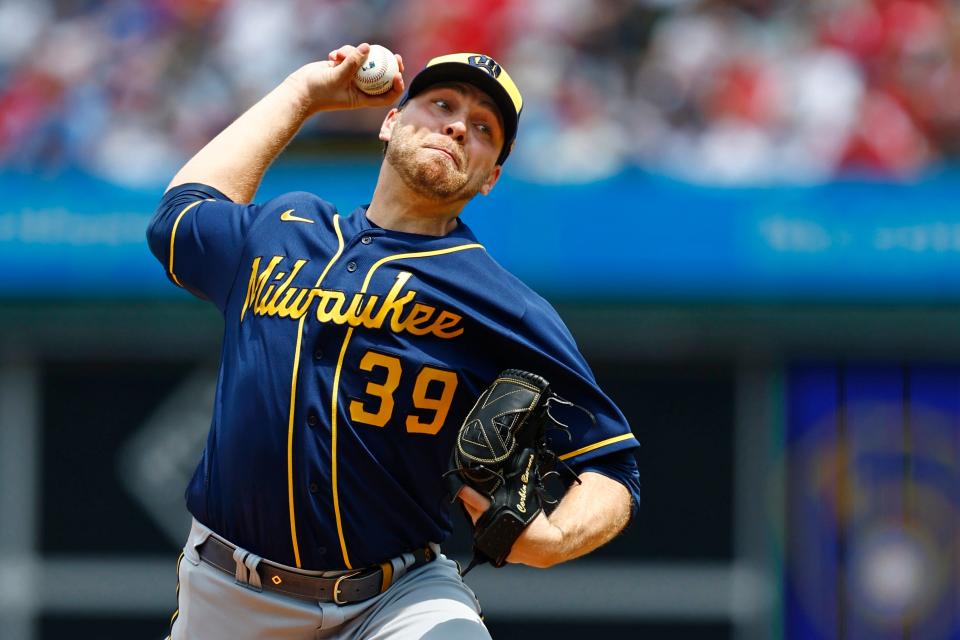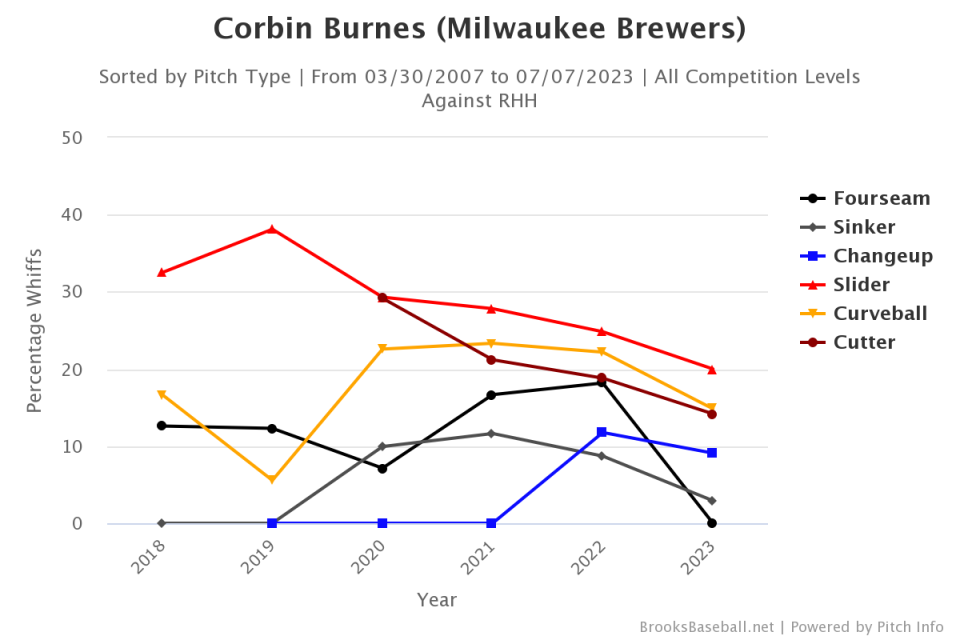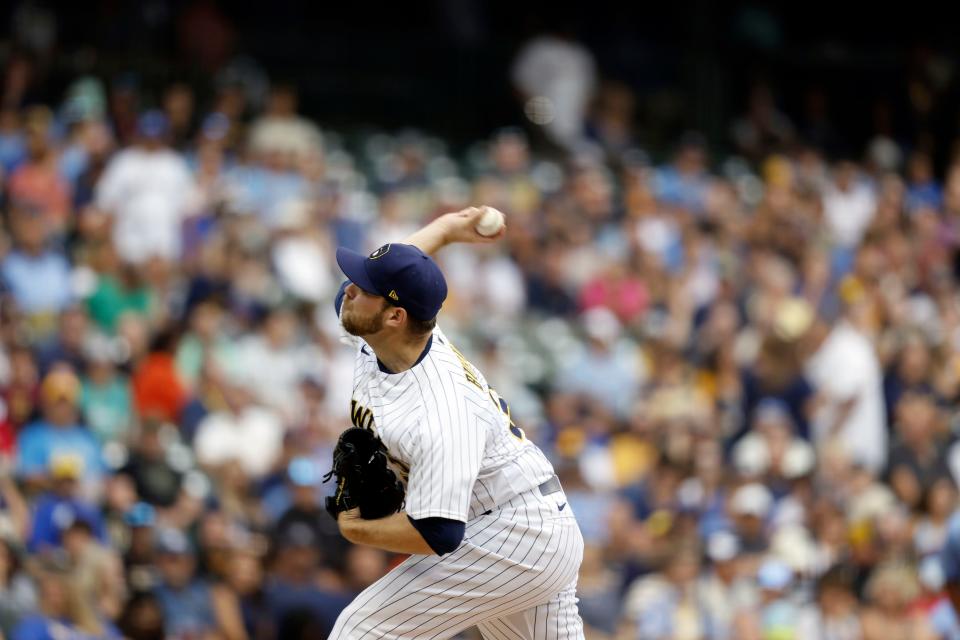Inside Corbin Burnes' quest to remain one of baseball's elite starting pitchers
ATLANTA – On June 2, Corbin Burnes opened an at-bat against the Cincinnati Reds’ Jonathan India with a cutter. The pitch was firm at 96 mph with plenty of bite and was located pretty well, just above the knees near the outside corner.
India crushed it, sending the pitch to right field for a two-run home run.
It was one of those pitches that, in year's past, Burnes would go back after the game and look at, jot down that it was executed how he wanted to and move on. After all, Burnes always repeats, he can’t control the results.
But the results were starting to get difficult to ignore.
Entering May 2023, the Milwaukee Brewers right-hander had never given up more than one home run on a cutter to a right-handed batter in a single month. He had allowed eight in total to righties in 79 games since he started throwing the cutter in 2020.
India’s was the fourth in Burnes’ last six starts. A Kyle Farmer blast two outings later in Minnesota marked five in a span of eight starts.
“Right handers were starting to sit out on it,” Burnes said.

Burnes has confidence in his cutter, but even he had to face the reality that it was time to make a change.
“That’s kind of what righties were doing, knowing that, ‘Hey everything’s moving away and going away,'" Burnes said. "They were looking away."
How long do elite pitches remain elite without an adjustment?
Burnes’ recent adjustments have received plenty of attention. He’s upped his curveball usage to righties and started throwing an entirely new pitch – more on that later – but let’s take a different approach to what’s been happening with Burnes, his pitch mix and the league.
“I think there’s a different way to look at this,” Brewers pitching coach Chris Hook suggested. “And maybe a better way.”
The thinking was that it isn’t so much that Burnes had to make adjustments, because every player in baseball has to make adjustments. But rather, the query posed was along the lines of: How long do elite pitches remain elite until the league starts to adjust to them?

Cutter results declined for Burnes through three months this season
There are, of course, the outliers, the Cooperstown pitches. Clayton Kershaw’s slider. Max Scherzer’s slider. Gerrit Cole’s fastball.
There are also unhittable reliever pitches that never get figured out. Mariano Rivera’s cutter. Josh Hader’s sinker. Devin Williams' Airbender.
But for just about every starting pitcher, no matter how dominant a certain pitch may be at its peak, the league eventually starts to figure out their arsenal if adjustments aren’t made.
It just took hitters longer to start figuring out Burnes’ cutter than it usually does.
In 2021, Burnes' cutter held opponents to a .237 average, .328 slugging percentage and .290 weighted on-base average. According to Statcast, it had a .199 expected batting average (xBA) and .255 expected weighted on-base average (xwOBA).
In 2022, the results were equally great; the average and wOBA were .213 and .292, respectively. The cutter was the eighth most valuable pitch in baseball according to Statcast's run value metric at +21 runs.
Through July 7 of this year, the point at which Burnes began throwing his curve more and changed his slider, he still had a low average against his cutter at .231, but hard contact against it had led to a .315 wOBA and .347 xwOBA.
The league almost always comes around on elite pitches
Burnes and Hook both noted independently how long they felt it took for batters to start jumping the cutter.
“Right-handers had made the adjustment,” Burnes said. “It took them two or three years to do it, but they finally made the adjustment and knew what they were doing.”
Said Hook: “They started to put more good swings on it, yeah, but it took until Year 4 of him throwing the cutter.”
Even elite pitches, turns out, for the most part have high variance year over year.
Take the top 20 individual pitches from 2021. The next season, the mean batting average on those same 20 pitches climbed 45 points from .187 to .233. The mean wOBA and xwOBA also climbed significantly, with a 42-point swing in the wOBA from .258 to .302.
Or, put simply, the average wOBA on those 20 pitches went from 56 points below league-average in 2021 to just eight points below in '22.
Pitch types | Avg. | wOBA | xwOBA | Run Value/100 pitches |
MLB top 20 SP pitches '21 | .187 | .258 | .271 | +1.9 |
Those same pitches in '22 | .233 | .302 | .298 | +0.4 |
Burnes' cutter in 2021 | .237 | .290 | .255 | +1.6 |
Burnes' cutter in 2022 | .213 | .292 | .312 | +1.2 |
Of the top 25 most valuable pitches in MLB according to Statcat's run value in 2021, Burnes' cutter and Carlos Rodon's fastball were the only two pitches that repeated being among that group again in 2022.
The takeaway: A single pitch can dominate the league for an entire season, but it's incredibly difficult to replicate those results sans adjustments the very next year.
The same remained true from 2022-23, as well. In fact, the top 20 pitches from last year actually have combined for a wOBA against that is worse than league-average.
Once again, the league's improvement against Burnes' cutter was still much more minor compared to 2022's other elite pitches.
Pitch types | Avg | wOBA | xWOBA | RunValue/100 pitches |
MLB top 20 SP pitches '22 | .179 | .254 | .271 | +1.8 |
Same pitches, but in '23 | .249 | .329 | .326 | +0.4 |
Burnes' cutter in 2022 | .213 | .292 | .312 | +1.2 |
Burnes' cutter thru 7/6/23 | .251 | .315 | .347 | +0.5 |
Burnes taught himself a new slider on the fly
Burnes has regained elite form, but the tweaks, aside from the new slider, have been what Hook deemed "subtle."
"I think all great players are stubborn," Hook said. "To me, that’s what you see. They’re stubborn to their routine. They’re stubborn to, 'This works, I’m doing to keep going.' If they find a soft spot in that then they make an adjustment.
"You talk to elite players, there’s a consistency in their work. I think Corbin has that. He’s got an elite preparation process. And, again, it's, 'I’m going to keep coming with what’s got me here.' Then if he needs to make a turn, he makes a turn. And he’s made a subtle turn."
Burnes realized he needed to make a turn because there was another warning sign flashing.
He wasn't getting whiffs like he needs to.
From 2020-22, among 100 pitchers to throw at least 2,000 pitches, nobody had a higher swing and miss percentage than Burnes at 35.6%. That number declined precipitously in the first half this year to 23.5%.

It was the main reason why Burnes didn’t look like Corbin Burnes.
Burnes' greatest skill is perhaps his ability to spin the ball, so he accessed that while tinkering with different pitch grips while throwing bullpens and playing catch in early July.
In the sixth inning against the Reds on July 7, he decided to give the new sweeping slider he had been experimenting with a whirl. The hitter, Matt McLain, swung and missed.
That's all that it took for Burnes to start throwing what was effectively a new pitch for him regularly in games.
"As good as Corbin is, I don’t think people understand his ability to spin the baseball," Hook said. "It’s beyond elite. He can shape it how he wants. It’s not about work in the bullpen. It’s the elite feel and ability. He can say, 'Hey I want the ball to go this way,' and it does."
On July 7, Burnes got 9.6 inches of horizontal break on his slider, up from his season average of six inches. His first start back from the break was 12.4 inches.
It's averaged 15.7 inches since.
Burnes is throwing the pitch slower, but at its velocity range – 83 to 85 mph – it currently tracks as a complete outlier pitch in terms of horizontal movement.
Burnes is getting the whiffs he wants on it, too. Over his last three starts, two-thirds of swings on the slider have come up empty.
“I don’t need it as something to put it in play like a ground ball,” Burnes said. “It’s, for me, a swing and miss for a punch out. I can use the cutter for a ground ball. I can use the sinker for a ground ball. I just didn’t need another pitch that was a put-it-in-play pitch. I was trying to find something that was a little bit different and gets more swing and miss.”
The cutter, though, is still going to be Burnes' bread-and-butter pitch.
Even with a relatively rough outing with the cutter against the White Sox on Friday in which Burnes had a tough time locating the pitch and served up some hard contact with it, opponents still only have a .169 average and .249 wOBA against the cutter in the second half.
The pitch carries a run value of 6.5 in that time, as well.

Should Burnes throw the cutter less with men on?
While it's difficult to pick out any trends from single-game pitch usage logs – for instance, Burnes struggled while throwing the cutter heavily on Saturday, but two of his three games of eight shutout innings this year featured high cutter usage – but one number does stand out.
Burnes has been notably worse with runners on base this year, allowing an OPS against of .717. Opponents are batting .263 with runners in scoring position. Without anyone on base, they have a .171 average and .520 OPS.
It's in those spots where the cutter has been most vulnerable. Opponents are batting .288 with a .388 wOBA and six homers. The cutter isn't getting grounders in those situations, with an average launch angle of 13 degrees.
The curveball, meanwhile, has resulted in one hit with men on while being thrown 17% of the time. It has a whiff rate of 52.1% with runners on.
The changeup has a whiff rate of 26.2% in those situations as well as a -1.7 degree launch angle and a bevy of weak contact that has resulted in a .199 xwOBA.
The revamped slider has also been shown to be a lethal swing-and-miss pitch to righties.
Yet the cutter is still Burnes' primary pitch with runners on and by a wide margin, being thrown 54% of the time. He's only getting a 23% whiff rate with it in those spots.
There's an argument to be made Burnes should decrease his cutter usage when he finds himself in a jam. Burnes himself even hinted at something similar in a recent conversation.
"Usually it’s been right handers because they’ve been zeroing in on one location or one pitch," Burnes said recently of how he often gets in trouble with the cutter. "It’s not perfectly executed then they can take advantage of it. By mixing it up, by being a little more balanced, makes them want to put some more lefties back in there and that plays right into my hand and makes it a tough decision."
For the first time since his disastrous 2019 season, the need for adjustments are back in Burnes' hands this year.
The flashes of greatness, or the capacity to be the best pitcher in baseball, are in there. Burnes was just the National League's pitcher of the month in July. He had a 2.00 ERA and held opponents to a .117 average over a seven-start stretch before the slip-up in Chicago over the weekend.
With his lethal pitch mix and uncanny ability to spin the ball, Burnes may just be a couple more slight adjustments away from reaching his ceiling again.
More: Why do scouts love this Brewers draft class (and specifically Cooper Pratt)?
This article originally appeared on Milwaukee Journal Sentinel: Adjustments part of Corbin Burnes' quest to remain an elite pitcher

